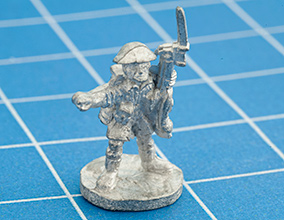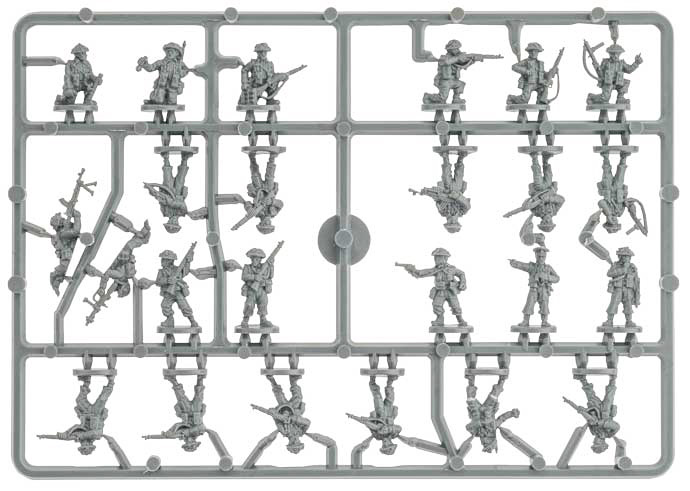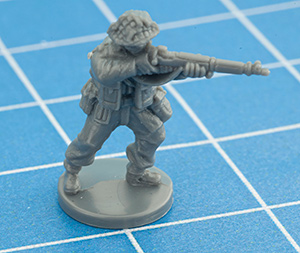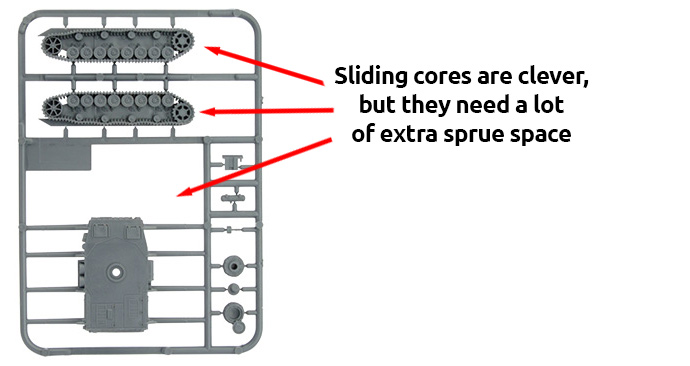
|
| |
|
|
|
|
Metal, Resin and Plastic Miniatures
|
Metal
Even before there was wargaming, toy soldiers have been cast in ‘white metal’ - a catch-all term for various alloys including lead, tin and a variety of other metals like copper and bismuth, which have fairly low melting points. These metals used to be cheap, but in recent years the price for the most useful, especially tin, has been steadily rising, making it less of an attractive option.
Metal figures are centrifugally cast in circular vulcanised rubber moulds. The circular moulds are spun in a casting machine. Molten metal is poured into a central feed and the spinning action forces it through the mould cavities.
|
 |
|
Pros:
- Decent detail
- Because the mould is flexible, it can peel around the figure, allowing ‘undercuts’ - areas of detail around the sides of the figure.
- Fairly quick. Once the rubber moulds are properly prepared, they can be ‘run’ over and over in a fairly continuous rotation, producing hundreds of figures per day. Care and skill is still needed to keep the moulds from wearing out or being damaged.
Cons:
- Heavy. No problem with a single small figure, but it adds up with a whole army.
- Somewhat fragile. Rifles, bayonets etc, can easily get bent, and the weight of the models also makes it more likely for paint to chip or scratch if they are dropped or handled carelessly.)
|
|
 |
 |
Hard Plastic
Injection-moulded plastic is what most of our newer vehicle kits are made from, as well as some of our major infantry ranges. Our vehicle models are designed used 3D CAD software, which is used with a computer-controlled cutting tool to produce the rigid steel ‘tool’ - the mould into which the liquid plastic is injected. CAD design process is ideal for straight-line models like vehicles, and in recent years 3D sculpting software has also allowed the design of ‘organic’ forms like human figures as well. However, the computer-controlled cutting of metal ‘tools’ is much better suited to straight-line shapes. Our infantry sprues have been prepared using an older manual process, which gives a much better result but is slow and even more expensive.
|
Pros:
- Easy to transport
- Resilient - because they’re light, if you drop them it’s no big deal.
- Very quick to produce. ‘Running’ the tool is a mostly automated process, producing hundreds of sprues per hour.
Cons:
- Cheap to produce each sprue, but expensive and time-consuming to set up in the first place. Each ‘tool’ - costs many thousands of dollars to produce.
- No undercuts at all - because the mould is rigid and so is the plastic, they have to be smooth on the sides to allow the sprues to slide out of the tool. So each figure has to be very carefully posed to avoid unsightly loss of detail on the sides. This gets harder the more gear the figures have. We can alleviate this by building special sliding parts into the tool, but that’s expensive, and it takes up a lot of space on sprues; we use it our vehicle models to get detail on the sides pieces, to keep the number of parts down, but it’s not practical for infantry figures there is simply not enough space on frames.
|
 |
|
 |
| Resin
We have done a small number of figures in resin, such as the Soviet artillery staff team (above). Two-part epoxy resin works by mixing two chemicals together, then pour the liquid into a flexible mould. A vacuum chamber is then used to suck out any air bubbles. The two parts go through a chemical reaction and become a solid resin.
Pros:
Cons:
- A little more fragile than plastic.
- Slow. Casting figures in this way requires care and skill, and each mould can only produce a few casts per day.
|
|
|
|
|
 |
|